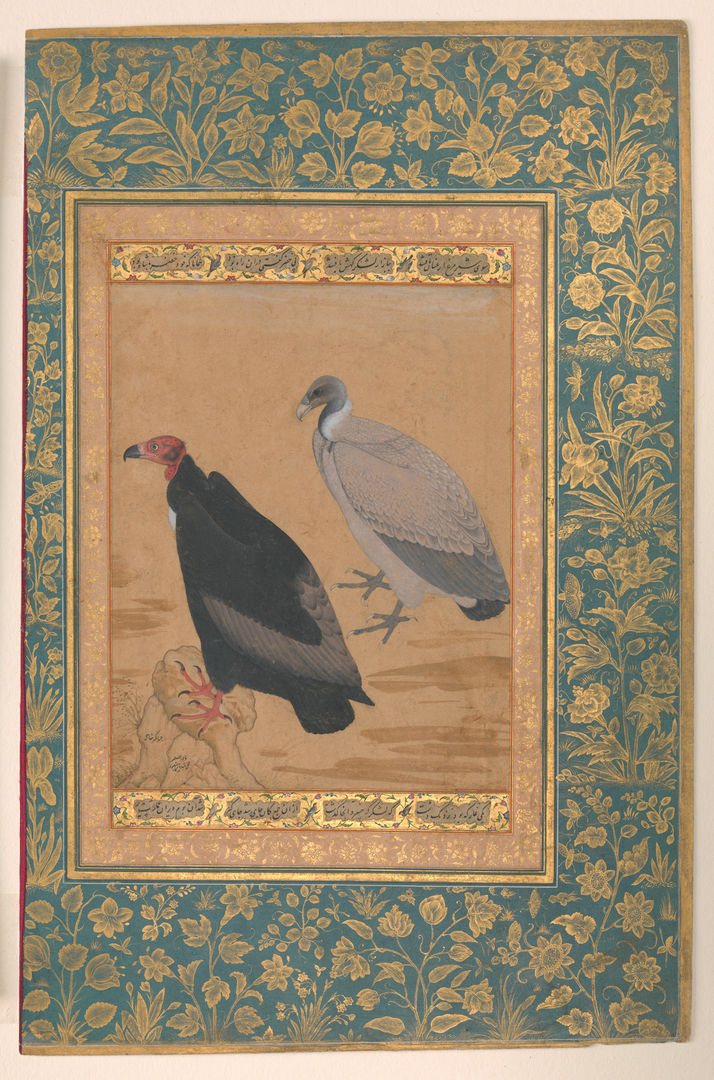The Mughal Court and the Art of Observation

Mansur (active 1589–1629). Red-Headed Vulture and Long-Billed Vulture: Folio from the Shah Jahan Album (verso), about 1615–20. India. Ink, opaque watercolor, and gold on paper, 15 3/8 x 10 1/16 in. (39.1 x 25.6 cm). The Metropolitan Museum of Art, New York, Purchase, Rogers Fund and the Kevorkian Foundation Gift, 1955 (55.121.10.12)
Collection Area: Islamic Art
Subject Areas: Geography, Science, Visual Arts, World History
Grades: Middle School, High School
Topic/Theme: Art and the Environment
Goals
Students will be able to:
- recognize ways works of art reflect an intense interest in observation of the human and natural world among Mughal leaders; and
- understand ways works of art from the past and present communicate ideas about the natural world.
National Learning Standards
Geography
NSS-G.K-12.5 Environment and Society
Science
NS.K-12.3 Life Science
Visual Arts
NA-VA.K-12.4 Understanding the Visual Arts in Relation to History and Cultures
NA-VA.K-12.6 Making Connections between Visual Arts and Other Disciplines
World History
NSS-WH.5-12.6 Era 6: The Emergence of the First Global Age, 1450–1770
Common Core State Standard
English Language Arts
CCSS.ELA-Literacy.CCRA.R.7 Integrate and evaluate content presented in diverse formats and media, including visually and quantitatively, as well as in words.
Questions for Viewing
- Take a close look at the two birds in the center of the composition. What similarities do you notice? What differences stand out?
- Compare the painting of the birds with images or videos (see Resources below) of the same species, the red-headed vulture and long-billed vulture. What do you think this artist felt was most important to convey? What do you see that makes you say that?
- Turn your attention to the setting. What might it suggest about the birds' habitat?
- Investigate the flora and fauna featured in the surrounding borders. How does the presentation of the natural world in the borders compare to the central image?
- Imagine creating a work such as this. What research or planning might be involved?
- The Mughal empire (1526–1858) was one of the most powerful and longest ruling in India. Mughal court artists had many opportunities to sketch animals and plants; they often accompanied leaders during royal hunts and had access to imperial zoos, which housed both native and foreign animals. What are some ways people in your community learn about plants and animals in their immediate environment and other regions?
- European merchants brought botanical albums with beautifully drawn and scientifically correct illustrations to India (see, for example, Le Jardin du Roy tres Chrestien Henry IV roy de France et de Navare). What does the featured work of art share in common with this illustration? What unique features distinguish each work?
- Mansur, the Mughal court artist commissioned to create this work, was one of Emperor Jahangir's (reigned 1605–27) favorite painters. What might this image suggest about Emperor Jahangir's artistic preferences and outlook on the natural world?
Activity
Activity Setting: Classroom or Museum
Materials: Images of a red-headed vulture and a long-billed vulture (or computer with Internet access to screen video clip; see Resources below), and an image of the French botanical illustration.
Subject Areas: Science, Visual Arts
Duration: Approximately 30 minutes
Compare and contrast representations of birds in works of art from around the world (see Objects in the Museum's Collection Related to this Lesson below). Consider the following points:
- What aspects of the bird(s) does the work emphasize? How does it create that emphasis?
- How would you describe the relationship between the subject and environment? Why?
- What animal behaviors, if any, does the work suggest?
- Who purchased or commissioned this work? What might have motivated the artist or the buyer?
- Based on the information you gathered, what might each work suggest about attitudes toward the natural world at that time and place?
Alternate Activity
Activity Setting: Outdoors
Subject Areas: Science, Visual Arts
Duration: Approximately 60 minutes
Take a nature walk or visit a zoo to closely observe animal life. During your trip, select one animal and sketch the following: the animal in action, two of its distinguishing features (for example, the beak, paws, or wings), and the environment in which it lives. Use the information you collect as a foundation for a finished artwork that conveys one key idea about the animal, such as how it moves, its relationship to its surroundings, or how one of its features helps it survive in the wild.
Resources
Alderfer, Jonathan. Waders and Waterfowl: Bird Illustration in Time-Lapse. Video. National Geographic Society, 1996–2012.
"Birding." In Connections. New York: The Metropolitan Museum of Art, 2000–.
Ekhtiar, Maryam D., and Claire Moore, eds. Art of the Islamic World: A Resource for Educators. New York: The Metropolitan Museum of Art, 2012.
Red-Headed Vulture (Sarcogyps calvus). Images and video. Arkive Images of Life on Earth. Wildscreen, 2003–2012.
Red-Headed Vulture Sarcogyps calvus. Online species factsheet. BirdLife International, 2012.
Viswanathan, Rashmi. "The Shah Jahan Album." In Heilbrunn Timeline of Art History. New York: The Metropolitan Museum of Art, 2000–.
Objects in the Museum's Collection Related to this Lesson
Constantin Brancusi (French, 1876–1957). Bird in Space, 1923. Marble, (with base) H. 56 3/4 in. (144.1 cm), diam. 6 1/2 in. (16.5 cm). The Metropolitan Museum of Art, New York, Bequest of Florene M. Schoenborn, 1995 (1996.403.7ab)
John James Audubon (American, 1785–1851). Goshawk, Stanley Hawk (No. 29), 1829. 38 1/4 x 24 1/4 in. (97.2 x 61.6 cm). The Metropolitan Museum of Art, New York, Robert Lehman Collection, 1975 (1975.1.2506)
Bird (sejen), 19th–mid-20th century. Côte d'Ivoire, northern Côte d’Ivoire. Senufo peoples. Wood, pigment, H. 59 5/8 x W. 23 1/2 x D. 14 1/4 in. (151.5 x 59.7 x 36.2 cm). The Metropolitan Museum of Art, New York, The Michael C. Rockefeller Memorial Collection, Bequest of Nelson A. Rockefeller, 1979 (1979.206.176)
Author: Adapted from a lesson by classroom teacher John Debold, 2012